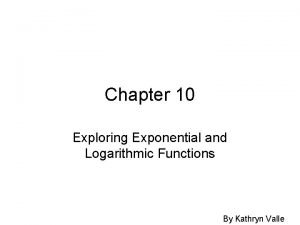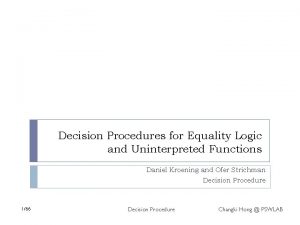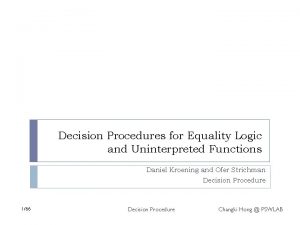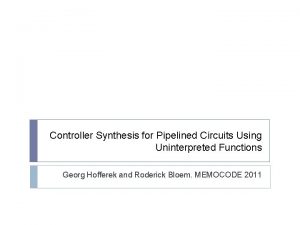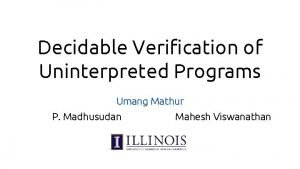Part 1 Positive Equality for Uninterpreted functions in





![EUF and small-model property Small Model Property for Validity [Ackermann ’ 54] n n EUF and small-model property Small Model Property for Validity [Ackermann ’ 54] n n](https://slidetodoc.com/presentation_image_h2/6a7a2e650e7fcc8e3b610ee4ee69e5c3/image-6.jpg)
![Positive Equality for EUF [Bryant, German, Velev CAV’ 99] General (g) Functions x, y Positive Equality for EUF [Bryant, German, Velev CAV’ 99] General (g) Functions x, y](https://slidetodoc.com/presentation_image_h2/6a7a2e650e7fcc8e3b610ee4ee69e5c3/image-7.jpg)






















































- Slides: 61

Part 1: Positive Equality for Uninterpreted functions in Eager Encoding

Eliminating Function applications n Two applications of an uninterpreted function f in a formula n f(x 1) and f(x 2) Ackermann’s Encoding Bryant, German, Velev’s Encoding f(x 1) vf 1 f(x 1) f(x 2) vf 2 f(x 2) x 1= x 2 vf 1 = vf 2 – 2– vf 1 ITE(x 1= x 2, vf 1, vf 2)

Positive Equality Optimization Goal n Replace as many of the vfi variables with constant values Exploit the positive structure of the formula Overall Benefit n n – 3– The function-free formula has smaller number of integer variables Reduces the number of interpretations to check for validity

Eliminating Function applications n Two applications of an uninterpreted function f in a formula n f(x 1) and f(x 2) Ackermann’s Encoding Bryant, German, Velev’s Encoding f(x 1) vf 1 f(x 1) f(x 2) vf 2 f(x 2) x 1= x 2 vf 1 = vf 2 – 4– vf 1 ITE(x 1= x 2, vf 1, vf 2) Favors positive equality analysis

EUF n Logic of Equality with Uninterpreted Functions Terms ITE(F, T 1, T 2) f (T 1, …, Tk) If-then-else Function application Formulas F, F 1 F 2 Boolean connectives T 1 = T 2 Equation p (T 1, …, Tk) Predicate application Special Cases v a – 5– Domain variable (order-0 function) Propositional variable (order-0 predicate)
![EUF and smallmodel property Small Model Property for Validity Ackermann 54 n n EUF and small-model property Small Model Property for Validity [Ackermann ’ 54] n n](https://slidetodoc.com/presentation_image_h2/6a7a2e650e7fcc8e3b610ee4ee69e5c3/image-6.jpg)
EUF and small-model property Small Model Property for Validity [Ackermann ’ 54] n n Suffices to consider a domain with k values n k is the number of distinct function application terms in the formula Number of cases (interpretations) to check: k! Function-application terms: {x, y, g(x), g(y), f(g(x), f(g(y) } = f = x g f g y (x=y) (f(g(x)) = f(g(y)) k=6 – 6–
![Positive Equality for EUF Bryant German Velev CAV 99 General g Functions x y Positive Equality for EUF [Bryant, German, Velev CAV’ 99] General (g) Functions x, y](https://slidetodoc.com/presentation_image_h2/6a7a2e650e7fcc8e3b610ee4ee69e5c3/image-7.jpg)
Positive Equality for EUF [Bryant, German, Velev CAV’ 99] General (g) Functions x, y Classify formulas, terms, functions into l Positive (p) l General (g) = p-formulas Positive (p) formulas l Negated even no. of times l Do not control ITE Positive (p) terms l – 7– f f p-terms = g g g-formulas Never appears in a g-formula equation Positive (p) function symbols l Positive (p) Functions f, g All applications are p-terms x y (x=y) (f(g(x)) = f(g(y))

Maximally Diverse Interpretations An interpretation I is maximally diverse if: n For any p-function symbol f 1. I [f(T 1) = f(T 2)] iff I [T 1=T 2] 2. I [f(T)] I [g(U)], for any other function symbol g where f(T 1), f(T 2), g(U) are terms in the formula = g h = g g x y – 8– Terms h x g (x) Equal? y g (y) y Potentially Only if x = y No

Maximally Diverse Interpretations An interpretation I is maximally diverse if: n For any p-function symbol f 1. I [f(T 1) = f(T 2)] iff I [T 1=T 2] 2. I [f(T 1)] I [g(U)], for any other function symbol g where f(T 1), f(T 2), g(U) are terms in the formula Property n – 9– Formula valid if and only if true under all maximally diverse interpretations

Justification of Maximal Diversity Property = g Create Worst Case for Validity n n n h = g g h x y Falsify positive equation Function applications yield distinct results Function arguments distinct For a formula F n – 10 – For any interpretation I, there is a maximally diverse interpretation J, such that J[F] I[F]

Exploiting Positive Equality Property n n n P-function symbol f Introduce variables vf 1, …, vfn during elimination Consider only diverse interpretations for variables vf 1, …, vfn l vfi v for any other variable v Example n Assuming vf 1 vf 2 : f(x 1) vf 1 x 1 = iff x 1=x 2 = x 2 – 11 – T vf 2 F f(x 2)

Summary: Positive equality optimization 1. Eliminate function applications 1. Introduce vf 1, …, vfn while eliminating function symbol f 2. For a p-function symbol f 1. Replace vf 1, …, vfn with distinct constants 3. The only variables in the function-free formula are the vfi variables for g function symbols n m = number of g-function applications – 12 –

Positive Equality for EUF Property n n Number of interpretations to consider = m! m = number of g-function applications General (g) Functions x, y Positive Functions f, g = f = x g f g y (x=y) (f(g(x)) = f(g(y)) – 13 –

Positive Equality for EUF General (g) Functions x, y Property n n Number of interpretations to consider = m! m = number of g-function applications Positive Functions f, g Function-application terms: {x, y, g(x), g(y), f(g(x)), f(g(y)) } p applications: {g(x), g(y), f(g(x)), f(g(y)) } g applications: {x, y} m=2 (x=y) (f(g(x)) = f(g(y)) Search Space reduced from 6! to 2! – 14 –

Application of positive equality Pipelined processor verification l Bryant, German and Velev CAV’ 99, Velev and Bryant DAC’ 00, . . n Observation: Most uninterpreted functions which appear in pipeline data-path are p-functions l E. g. ALU, Incrementer for PC, …. Other Infinite-state system verification l Bryant, Lahiri, Seshia CAV’ 02 n – 15 – Improves efficiency in benchmarks from cache-coherence verification, out-of-order processors, software benchmarks

Impact of Positive Equality Model Initial formula size UCLID w/ p-eq. (s) UCLID w/o p-eq. (s) SVC time (s) Out-of-order proc 3929 61. 90 149. 46 Cache coherence 3939 61. 08 > 1 hr > 1 day 639 13. 22 1897 > 1 day DLX pipeline 4257. 3 Positive equality can be exploited to improve performance [Bryant, Lahiri, Seshia CAV’ 02] – 16 –

Ackermann’s encoding and positive equality n Two applications of an uninterpreted function f in a formula n f(x 1) and f(x 2) Can’t assign distinct values to vf 1, vf 2 for p-function symbol f Ackermann’s Encoding n f(x 1) vf 1 f(x 2) vf 2 x 1= x 2 vf 1 = vf 2 – 17 – Ignores the case when x 1= x 2

Limitation of positive equality analysis Limitation of previous approach n Not “robust” General Functions x, f l Entire analysis fails even Positive Functions = when a single application is negative f f f Function-application terms: {x, f(x), f 2(x), f 3(x), f 4(x) } p-applications: {} – 18 – g-applications: {x, f(x), f 2(x), f 3(x), f 4(x) } = f x (f(x)=x) (f(f(x)))) = f(f(f((x)))

Robust Positive Equality Analysis Look at each application instead of function symbols n n Finer granularity for exploiting positive equality General Functions x, f Positive Functions = [Lahiri, Bryant, Goel, Talupur TACAS’ 04] f f f Function-application terms: {x, f(x), f 2(x), f 3(x), f 4(x) } p-terms: 2 { f (x), f 3(x), f 4(x) } – 19 – g-terms: {x, f(x)} = f x (f(x)=x) (f(f(x)))) = f(f(f((x)))

Robust Positive Equality Analysis Goal n If a variable vfi is a result of eliminating a p-term, then try to assign it a distinct constant Question n Can we always assign the vfi variables for any p-term a distinct value? l Not always n Can we compute the set of p-terms that maximizes the number of vfi variables that can be assigned distinct values? l In general, NP-complete – 20 –

Outline Robust positive equality n “Robust” maximal diversity theorem Exploiting robust positive equality n n Obstacles Solutions Results Related work – 21 –

Robust Maximal Diversity For an interpretation I n A p-term f(T) is called is g-arg-distinct, if there is no g-term f(U), such that I [T] = I [U]. An interpretation I is robust maximally diverse if: n For every g-arg-distinct p-term f(T 1), 1. I [f(T 1) = f(T 2)] iff I [T 1=T 2] 2. I [f(T)] I [g(U)], for any other function symbol g where f(T 1), f(T 2), g(U) are terms in the formula – 22 –

Example I = {x, f 2(x), f 4(x)}, {f(x), f 3(x)} For an interpretation I n A p-term f(T) is called is g-arg -distinct, if there is no g-term f(U), such that I [T] = I [U]. Non robust-maximally diverse interpretation G-term – 23 – For every g-arg-distinct p-term f(T 1), 1. I [f(T 1) = f(T 2)] iff I [T 1=T 2] 2. I [f(T)] I [g(U)], for any other function symbol g where f(T 1), f(T 2), g(U) are terms in the formula f f An interpretation I is robust maximally diverse if: n = P-term g-arg-distinct f = f Equals non f term x (f(x)=x) (f(f(x)))) = f(f(f((x)))

Robust Maximal Diversity Theorem n Formula valid if and only if true under all robust maximally diverse interpretations Generalization of positive equality n Any robust-maximally diverse interpretation is a maximally diverse interpretations l The subset inclusion can be proper Consequence n – 24 – Fewer interpretations to consider to check validity

Exploiting Robust Positive Equality n Function applications f(x 1), …, f(xn) n Introduce variables vf 1, …, vfn during elimination f(x 1), …, f(xl), …, f(xi), …, f(xn) Contains all the g-terms for f Value of vfi = Value of f(xi) n when xi does not equal {x 1, …, xi-1} n – 25 – i. e. when f(xi) is g-arg-distinct By Robust maximal diversity theorem n Assign a distinct constant to vfi , when i>l

What we need Eliminate the g-terms as early as possible n n Constrained by the sub-expression ordering e. g. f(x) has to be eliminated before eliminating f(f (x)) Need the best topological order n Respects the sub-expression orderings n Maximizes the number of vf variables that can be assigned distinct constant value l Need to define this objective function precisely – 26 –

Function elimination and topological order Requires a topological order on the terms n n Respects the subexpression order Eliminate functions from sub-terms first = f f f = Example order n x, f(x), f 2(x), f 3(x), f 4(x) n Only order for this example f x (f(x)=x) (f(f(x)))) = f(f(f((x))) – 27 –

Function elimination and topological order l vf variables for every pterm can’t be assigned distinct values n = P-terms that are subterms of a g-term with the same function. f f = f f Example order – 28 – n x, f(x), f 2(x), f 3(x), f 4(x) n Only order for this example x Always precedes the g-term f 2(x) (f(f(x))=x) (f(f(x)))) = f(f(f((x)))

Topological ordering and the p-terms n Topological order < Pos<(f) n Set of p-terms of f which do not precede any gterms of f in < Pos< = f Pos<(f) – 29 –

Topological ordering: Example 1 n Topological order < Pos<(f) n = Set of p-terms of f which do not precede any gterms of f in < f + f + Pos< = f Pos<(f) = f Example nx< f(x) < f 2(x) < f 3(x) < f 4(x) n. Pos< = {f 2(x), f 3(x), f 4(x)} – 30 – x (f(x)=x) (f(f(x)))) = f(f(f((x)))

Topological ordering n Topological order < Property l Pos<(f) n Set of p-terms of f which do not precede any gterms of f in < Pos< = f Pos<(f) – 31 – The vfi variables which results when eliminating terms in Pos< can be assigned a distinct constant value Goal l Find the topological order “<” that maximizes the size of Pos<

Finding the best topological ordering With multiple non-zero arity function symbol n Best order may not be best for each symbol Not best for = g Example g f f 1. 2. x< f(x)<g(f(x))<g(x)<f(g(x)) Pos< = {x, g(x)} 3. x<g(x)< f(x)<g(f(x))<f(g(x)) Pos< = {x } – 32 – g Not best for 3 topological orders on terms x<g(x)<f(g(x))<f(x)<g(f(x)) n f Pos< = {x, f(x)} x (f(g(x)) = g(f(x)))

Obtaining best topological order Complexity n NP-complete l Polynomial when only 1 non-zero arity function symbol n Reduction from the maximum independent set problem Greedy heuristic to find a good order – 33 – n Assign higher priorities to p-terms of functions with greater number of “potential” terms in Pos< n Finds the optimal order for most of the examples we have seen so far.

Sample Results n Implemented in UCLID decision procedure l With Zchaff SAT-solver n Code Validation Benchmarks l [Pnueli, Rodeh, Strichman, Siegel CAV’ 99] example #vars Positive Equality #pvar – 34 – time Robust Positive Eq Speedup #pvar time Cv 22 101 1 70. 84 16 45. 65 1. 55 Cv 44 38 8 19. 75 17 7. 13 2. 77 Cv 46 70 10 >1800 28 100. 50 >18

Observations Robust positive equality improves efficiency n Useful in practice Small overhead (+5%) over positive equality analysis n n – 35 – Efficient implementation can further reduce this overhead Seldom affects total time when translation time to SAT is a small fraction of the overall time

Related work Pnueli, Rodeh, Strichman & Siegel CAV’ 99 n Removes function applications by Ackermann’s reduction n Range allocation for the resultant formula l Assigns smaller ranges for g-terms Rodeh & Strichman CAV’ 01 n n – 36 – Uses Bryant, German & Velev’s function elimination method + range allocation Has similarities and differences with our work

Conclusions Positive Equality n Simplifies function-free formula by reducing the number of variables in the formula Robust Positive Equality n n Generalization of positive equality Improves applicability for more general benchmarks Can be extended for CLU logic – 37 – n T 1 < T 2 + c [BLS 02; Lahiri MS Thesis] n Can we generalize it for linear arithmetic + EUF?

Questions – 38 –

Decision Procedure Benchmarking Compared against Stanford Validity Checker (SVC) & its successor CVC (which uses Chaff) • Decides CLU + real linear arith. + bit-vector arith. UCLID uses Chaff for Boolean SAT • UCLID time = translation time + Chaff time Model Out-oforder Term formula DAG size Prop formula DAG size UCLID time (s) SVC time (s) CVC time (s) 735 3658 4. 8 3. 0 6. 16 1970 13755 18. 3 102. 4 90. 75 Unit 3929 37179 61. 9 Elf™ 218 942 1. 2 10. 9 0. 25 1085 4481 8. 4 1851. 6 114. 46 2467 16453 30. 6 > 1 day Out of Mem 4553 54288 111. 0 > 1 day Out of Mem execution processor – 39 – 4257. 3 Out of Mem

Impact of Positive Equality Model Out-of-order Term formula size UCLID w/ p -eq. (s) UCLID w/o peq. (s) 735 4. 78 9. 79 1970 18. 29 37. 71 3929 61. 90 149. 46 Cache 1829 6. 29 26. 50 Protocol 2782 16. 13 165. 91 3939 61. 08 > 1 hr 639 13. 22 1897 execution unit DLX pipeline Positive equality can be exploited to improve performance – 40 –

Exploiting Positive Equality Property n n n P-function symbol f Introduce variables vf 1, …, vfn during elimination Consider only diverse interpretations for variables vf 1, …, vfn l vfi v for any other variable v Example n Assuming vf 1 vf 2 : vf 1 x 1 = iff x 1=x 2 = x 2 – 41 – T vf 2 F

Compare: Ackermann’s Method Replacing Application n Introduce new domain variable n Enforce functional consistency by global constraints x 1 = x 2 n – 42 – vff 1 = vff 2 F Unclear how to generate diverse interpretations

Decision Procedures in Verification Work-horse for many automated verification methodologies n Processor and Protocol verification l Pipelined processor verification » Burch & Dill CAV’ 94, Bryant, German & Velev CAV’ 99, … l Out-of-order processor and cache coherence verification » Lahiri, Seshia & Bryant FMCAD’ 02, Bryant, Lahiri & Seshia CAV’ 02 n Predicate abstraction l Software verification » SLAM (MSR), BLAST (Berkeley), MAGIC (CMU), … l Protocol verification » Das, Dill & Park CAV’ 99, – 43 –

Decision Procedures for quantifierfree fragment of first-order logic Principal theories n n Logic of equality with uninterpreted functions l f(x) = f(g(y)) Linear arithmetic l Difference-bound logic subset ( T 1 < T 2 + c) l Full linear arithmetic n Arrays l read and write operations Tools n n n – 44 – SVC/CVC from Stanford (FMCAD ’ 96, CAV’ 02, CAV ‘ 04) UCLID from CMU (CAV’ 02, CAV’ 04) ICS from SRI (CAV ’ 01) Simplify/Verifun from HP (CAV ’ 03) Zapato from Microsoft (CAV ’ 04) ……

Revisiting Positive Equality Shuvendu K. Lahiri Randal E. Bryant Amit Goel Muralidhar Talupur Carnegie Mellon University

Conclusions Generalization of Bryant et al’s positive equality analysis n Subsumes original positive equality Exploiting robust positive equality in a decision procedure n Problems and heuristics Future Work n Integrate smaller range-allocation for the g-terms l Pnueli et al. CAV’ 99, Talupur et al. CAV’ 04 – 46 –

Positive Equality for EUF Split the set of terms into n p-terms General (g) Functions x, y l Function applications of p- = functions n Positive Functions f, g g-terms l Function applications of g- f f functions = x g g y (x=y) (f(g(x)) = f(g(y)) – 47 –

Definition P-term n Term which never appear in equations that are gformulas = n f G-term f Term which appears at least once in an equation that is a g-formula = f p-terms f g-terms x (f(x)=x) (f(f(x)))) = f(f(f((x))) – 48 –

Eliminating Function Applications n Bryant, German & Velev CAV’ 99 Replacing Application n n Introduce new domain variable Nested ITE structure maintains functional consistency f vf 1 x 1 = f vf x 2 T 2 F = = x 3 – 49 – T f T vf 3 F F

Robust maximally diverse interpretations I = {x 0, f(0) 1, f(1) 0, . . } P-term h(T 1, …, Tn) n If args. do not equal the args. of any g-term h(U 1, …, Un), then l Can only equal other h application terms with equal arguments Non robust-maximally diverse interpretation P-term G-term Formula valid if and only if true under all robust maximally diverse interpretations f 0 f = 0 x f 1 0 1 f Property n = Args not equal with the g-term Equals non f term (f(x)=x) (f(f(x)))) = f(f(f((x))) – 50 –

Heuristic for obtaining topological order Potentially positive terms for a function f n The p-terms of f that are not sub-terms of any g-term of f Steps 1. 2. Sort the function symbols by the number of potentially positive terms For each function f in sorted order: n Put all the g-terms of f (and their subterms) in the topological order 3. – 51 – Put all the remaining pterms in the topological order

Heuristic for obtaining topological order Potentially positive terms for a function f n The p-terms of f that are not sub-terms of any g-term of f 2. Put the g-terms for f n x<g(x)<f(g(x)) Put the g-terms for g f n f(x)<f(f((x))<g(f(f(x))) Steps 1. Sort the functions n f; g; x Sort the function symbols by the number of potentially positive terms For each function f in sorted order: Put the g-terms for x + g n Already present = g f + n Put all the g-terms of f (and their subterms) in the topological order 3. – 52 – Put all the remaining pterms in the topological order x<g(x)<f(g(x))<f(x)<f(f(x))<g(f(f(x))) x + T<+ = {x, f(x), f(f(x))} (f(g(x)) = g(f(f(x))))

Definitions I = {x 0, f(0) 1, f(1) 0, . . } Interpretation I n n Assigns a value to all the functions appearing in a formula I(f) = function associated with the symbol f true false = f n. I n Defined inductively on the structure of e – 53 – f 1 0 f = Evaluation [e] evaluates e w. r. t. the interpretation I f true false 0 1 0 x (f(x)=x) (f(f(x)))) = f(f(f((x)))

Topological ordering: Example 2 n Topological order < T<+(f) n = Set of p-terms of f which do not precede any gterms of f in < f = T<+ = f T<+(f) f(x) < f 2(x) < f 3(x) < f 4(x) n. T<+ = {f 3(x), f 4(x)} – 54 – + f f Example nx< f + x Always precedes the g-term f 2(x) (f(f(x))=x) (f(f(x)))) = f(f(f((x)))

Results n Implemented in UCLID decision procedure l With Zchaff SAT-solver n Code Validation Benchmarks l [Pnueli, Rodeh, Strichman, Siegel CAV’ 99] example #vars Positive Equality Robust Positive Eq #pvar time #pvar |T+| time Cv 22 101 1 70. 84 16 18 45. 65 1. 55 Cv 23 101 8 23. 06 22 22 15. 96 1. 44 Cv 25 101 8 45. 93 22 22 21. 80 2. 10 Cv 44 38 8 19. 75 17 17 7. 13 2. 77 Cv 46 70 10 >1800 28 28 100. 50 >18 T+ = union of the set of potentially positive – 55 – Speedup terms for each function

Topological ordering: Example 2 n Topological order < Pos<(f) n = Set of p-terms of f which do not precede any gterms of f in < f = Pos< = f Pos<(f) f(x) < f 2(x) < f 3(x) < f 4(x) n. Pos< – 56 – = {f 3(x), f 4(x)} + f f Example nx< f + x Always precedes the g-term f 2(x) (f(f(x))=x) (f(f(x)))) = f(f(f((x)))

Finding the best topological ordering With multiple non-zero arity function symbol n Best order may not be best for each symbol = Example 1. 3 topological orders on terms x<g(x)<f(g(x))<f(x)<g(f(x)) Pos< = {x, f(x)} 2. x< f(x)<g(f(x))<g(x)<f(g(x)) Pos< = {x, g(x)} 3. x<g(x)< f(x)<g(f(x))<f(g(x)) Pos< = {x } n – 57 – f g g f x (f(g(x)) = g(f(x)))

Relevant papers l “Exploiting positive equality in a logic of equality with uninterpreted functions” n Bryant, German and Velev, CAV’ 99 l “Revisiting Positive Equality” n n – 58 – Lahiri, Bryant, Goel and Talupur, TACAS’ 04 Generalization of positive equality

Maximally Diverse Interpretations P-Function Symbols n n Equal results only for equal arguments Doesn’t equal application of any other function symbol G-Function Symbols n Potentially yield equal results for unequal arguments Property n – 59 – = Formula valid if and only if true under all maximally diverse interpretations g h = g g h x y Terms x g (x) Equal? y g (y) y Potentially Only if x = y No

Robust maximally diverse interpretations For every p-term h(T 1, …, Tn) n If args. do not equal the args. of any g-term h(U 1, …, Un), then l Can only equal other h application terms with equal arguments Property n – 60 – Formula valid if and only if true under all robust maximally diverse interpretations

Robust maximally diverse interpretations I = {x, f 2(x)}, {f(x), f 3(x)} P-term h(T 1, …, Tn) n If args. do not equal the args. of any g-term h(U 1, …, Un), then l Can only equal other h application terms with equal arguments Non robust-maximally diverse interpretation G-term f Formula valid if and only if true under all robust maximally diverse interpretations = x f f Property n = P-term f Arg not equal to the arg of g-term of f Equals non f term (f(x)=x) (f(f(x)))) = f(f(f((x))) – 61 –
 Formal equality vs substantive equality
Formal equality vs substantive equality Substantive equality vs formal equality
Substantive equality vs formal equality Chapter 10 exponential and logarithmic functions answers
Chapter 10 exponential and logarithmic functions answers Staphylococcus epidermidis en agar sangre
Staphylococcus epidermidis en agar sangre What's 8 + 5
What's 8 + 5 Positive practice positive outcomes
Positive practice positive outcomes Iso 22301 utbildning
Iso 22301 utbildning Typiska drag för en novell
Typiska drag för en novell Tack för att ni lyssnade bild
Tack för att ni lyssnade bild Vad står k.r.å.k.a.n för
Vad står k.r.å.k.a.n för Varför kallas perioden 1918-1939 för mellankrigstiden
Varför kallas perioden 1918-1939 för mellankrigstiden En lathund för arbete med kontinuitetshantering
En lathund för arbete med kontinuitetshantering Kassaregister ideell förening
Kassaregister ideell förening Tidbok för yrkesförare
Tidbok för yrkesförare A gastrica
A gastrica Vad är densitet
Vad är densitet Datorkunskap för nybörjare
Datorkunskap för nybörjare Stig kerman
Stig kerman Debatt artikel mall
Debatt artikel mall Delegerande ledarstil
Delegerande ledarstil Nyckelkompetenser för livslångt lärande
Nyckelkompetenser för livslångt lärande Påbyggnader för flakfordon
Påbyggnader för flakfordon Lufttryck formel
Lufttryck formel Publik sektor
Publik sektor Jag har nigit för nymånens skära text
Jag har nigit för nymånens skära text Presentera för publik crossboss
Presentera för publik crossboss Teckenspråk minoritetsspråk argument
Teckenspråk minoritetsspråk argument Kanaans land
Kanaans land Treserva lathund
Treserva lathund Fimbrietratt
Fimbrietratt Claes martinsson
Claes martinsson Cks
Cks Lågenergihus nyproduktion
Lågenergihus nyproduktion Bra mat för unga idrottare
Bra mat för unga idrottare Verktyg för automatisering av utbetalningar
Verktyg för automatisering av utbetalningar Rutin för avvikelsehantering
Rutin för avvikelsehantering Smärtskolan kunskap för livet
Smärtskolan kunskap för livet Ministerstyre för och nackdelar
Ministerstyre för och nackdelar Tack för att ni har lyssnat
Tack för att ni har lyssnat Referat mall
Referat mall Redogör för vad psykologi är
Redogör för vad psykologi är Matematisk modellering eksempel
Matematisk modellering eksempel Atmosfr
Atmosfr Borra hål för knoppar
Borra hål för knoppar Vilken grundregel finns det för tronföljden i sverige?
Vilken grundregel finns det för tronföljden i sverige? Beräkna standardavvikelse
Beräkna standardavvikelse Tack för att ni har lyssnat
Tack för att ni har lyssnat Rita perspektiv
Rita perspektiv Verksamhetsanalys exempel
Verksamhetsanalys exempel Tobinskatten för och nackdelar
Tobinskatten för och nackdelar Toppslätskivling dos
Toppslätskivling dos Mästar lärling modellen
Mästar lärling modellen Egg för emanuel
Egg för emanuel Elektronik för barn
Elektronik för barn Plagg i gamla rom
Plagg i gamla rom Strategi för svensk viltförvaltning
Strategi för svensk viltförvaltning Kung dog 1611
Kung dog 1611 Humanitr
Humanitr Romarriket tidslinje
Romarriket tidslinje Tack för att ni lyssnade
Tack för att ni lyssnade Avrunda decimaltal
Avrunda decimaltal Texter om sommaren
Texter om sommaren


